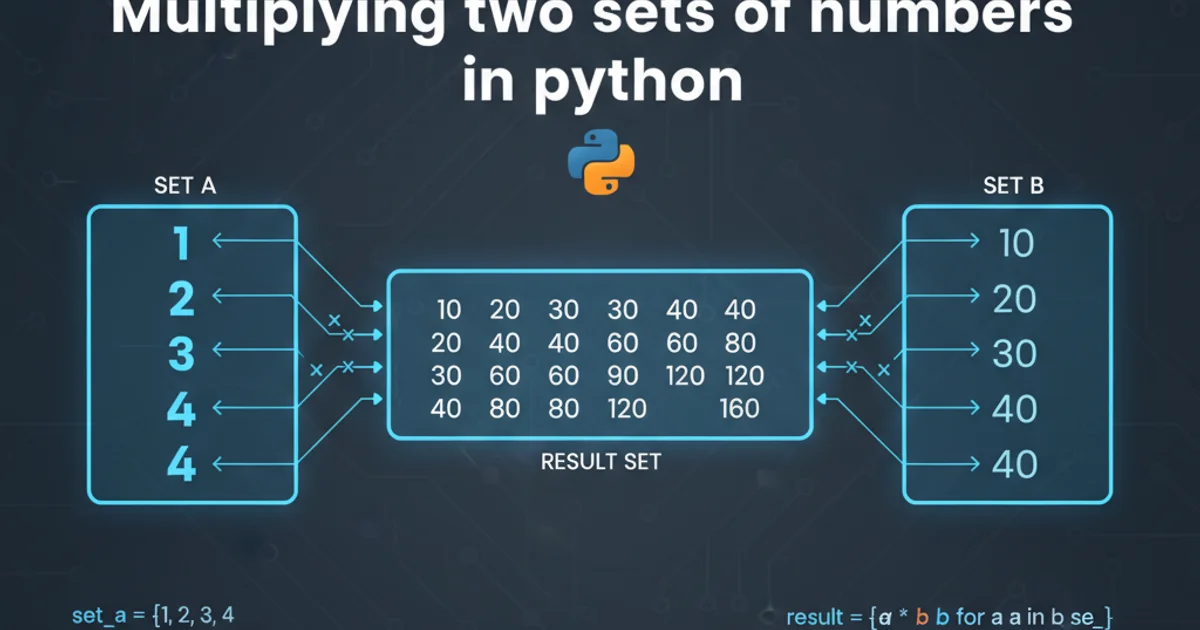Multiplying two sets of numbers in python
Categories:
Efficiently Multiplying Two Sets of Numbers in Python

Explore various Python techniques for multiplying corresponding elements from two lists or arrays, from basic loops to advanced NumPy operations, and understand their performance implications.
Multiplying two sets of numbers is a common task in programming, especially in data processing, scientific computing, and machine learning. In Python, there are several ways to achieve this, each with its own advantages in terms of readability, performance, and conciseness. This article will guide you through different methods, from fundamental looping constructs to leveraging powerful libraries like NumPy, helping you choose the most appropriate approach for your specific needs.
Understanding Element-wise Multiplication
When we talk about multiplying two sets of numbers, we typically refer to 'element-wise' multiplication. This means that the first element of the first set is multiplied by the first element of the second set, the second by the second, and so on. This operation requires that both sets have the same number of elements. If the sets have different lengths, you'll need to decide how to handle the mismatch (e.g., truncate, pad, or raise an error).
flowchart TD
A[Start]
B["Input: List 1 (L1)"]
C["Input: List 2 (L2)"]
D{Are lengths of L1 and L2 equal?}
E["Error: Length Mismatch"]
F["Initialize Result List (R)"]
G["Loop from i = 0 to length(L1) - 1"]
H["Calculate R[i] = L1[i] * L2[i]"]
I["Add R[i] to Result List"]
J[End]
A --> B
A --> C
B --> D
C --> D
D -- No --> E
D -- Yes --> F
F --> G
G --> H
H --> I
I --> G
G -- Loop Ends --> JFlowchart for Element-wise Multiplication Logic
Basic Approaches: Loops and List Comprehensions
The most straightforward way to perform element-wise multiplication is by iterating through the lists using a loop. Python's for loop is a natural fit for this. For more concise code, list comprehensions offer a Pythonic alternative that often improves readability and can sometimes be more efficient for simple operations.
list1 = [1, 2, 3, 4]
list2 = [5, 6, 7, 8]
# Using a for loop
result_loop = []
for i in range(len(list1)):
result_loop.append(list1[i] * list2[i])
print(f"Using for loop: {result_loop}")
# Using a list comprehension
result_comprehension = [list1[i] * list2[i] for i in range(len(list1))]
print(f"Using list comprehension: {result_comprehension}")
# Using zip with list comprehension (more Pythonic)
result_zip_comprehension = [a * b for a, b in zip(list1, list2)]
print(f"Using zip with list comprehension: {result_zip_comprehension}")
Demonstrates element-wise multiplication using for loops and list comprehensions.
zip() function is highly recommended when iterating over multiple sequences simultaneously. It stops when the shortest iterable is exhausted, which can be a useful feature or a potential pitfall if you expect all elements to be processed regardless of length.Advanced Approaches: NumPy for Performance
For numerical operations, especially with large datasets, Python's built-in lists can become inefficient. The NumPy library is the de facto standard for numerical computing in Python, providing high-performance array objects and tools for working with them. NumPy arrays support element-wise operations directly, making the code much cleaner and significantly faster.
import numpy as np
array1 = np.array([1, 2, 3, 4])
array2 = np.array([5, 6, 7, 8])
# Element-wise multiplication with NumPy
result_numpy = array1 * array2
print(f"Using NumPy: {result_numpy}")
# NumPy also handles broadcasting for compatible shapes
scalar = 10
result_broadcast = array1 * scalar
print(f"Using NumPy with scalar broadcasting: {result_broadcast}")
Element-wise multiplication using NumPy arrays.
Performance Comparison
To illustrate the performance differences, let's compare the execution time of these methods for larger lists. This will highlight why NumPy is preferred for numerical tasks involving substantial data.
import time
import numpy as np
size = 10**6 # One million elements
list1 = list(range(size))
list2 = list(range(size, size * 2))
# For loop
start_time = time.time()
result_loop = []
for i in range(len(list1)):
result_loop.append(list1[i] * list2[i])
end_time = time.time()
print(f"For loop time: {end_time - start_time:.4f} seconds")
# List comprehension with zip
start_time = time.time()
result_zip_comprehension = [a * b for a, b in zip(list1, list2)]
end_time = time.time()
print(f"List comprehension with zip time: {end_time - start_time:.4f} seconds")
# NumPy
array1 = np.array(list1)
array2 = np.array(list2)
start_time = time.time()
result_numpy = array1 * array2
end_time = time.time()
print(f"NumPy time: {end_time - start_time:.4f} seconds")
Performance comparison of different multiplication methods for large datasets.
As you can see from the performance comparison, NumPy significantly outperforms native Python loops and list comprehensions for large datasets. This is due to its underlying implementation in C, which allows for much faster array operations.